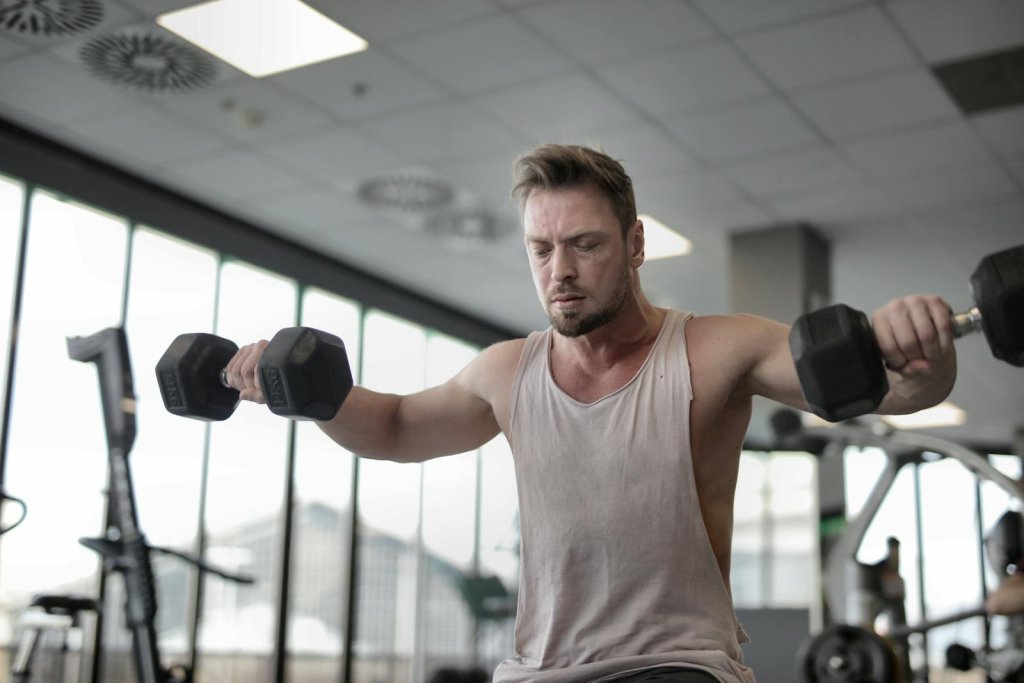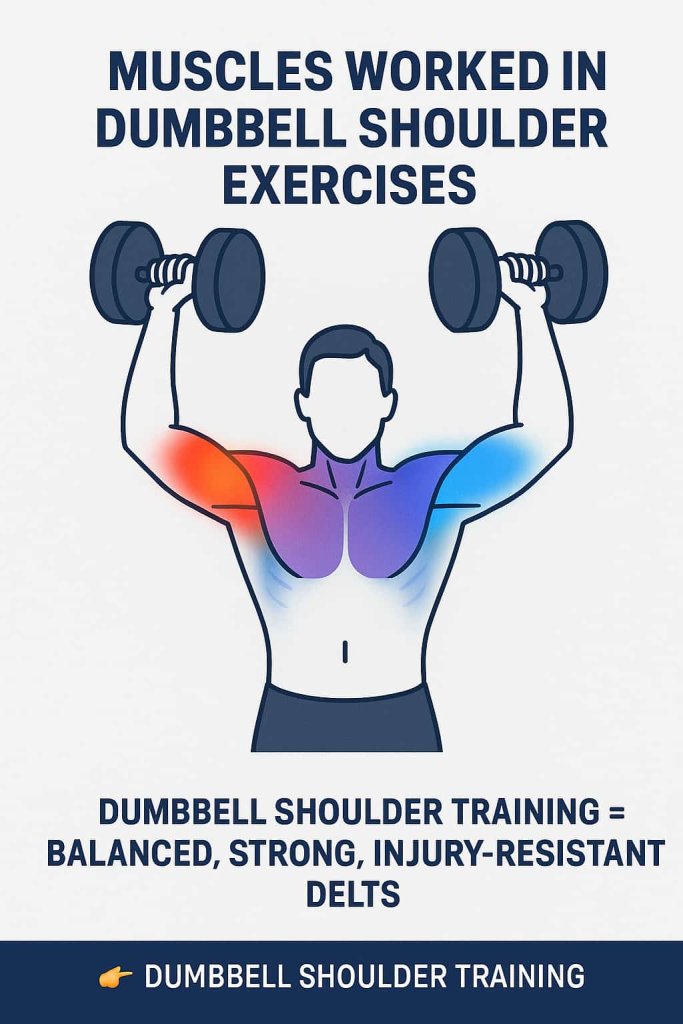Yes, dumbbells are one of the most effective tools for building strong, wide delts.
They allow for natural shoulder movement, greater range of motion, and targeted activation of each deltoid head (front, side, and rear). Training all three heads of the deltoid is essential not just for aesthetic “capped shoulders” but also for strength, posture, and injury prevention.

This guide covers the 15 best dumbbell shoulder exercises, based on research and expert recommendations. You’ll learn which muscles each move targets, step-by-step instructions, benefits, and pro tips. Whether you train at home or in the gym, these exercises can help you develop balanced, powerful shoulders.
Muscles Worked in Dumbbell Shoulder Exercises

- Anterior Deltoid (front) – Lifts the arm forward, activated in presses and front raises.
- Lateral Deltoid (side) – Lifts the arm outward, key for shoulder width.
- Posterior Deltoid (rear) – Pulls the arm backward, crucial for balance and posture.
- Trapezius & Upper Back – Assist in stability and elevation.
- Rotator Cuff & Core – Stabilize the shoulder joint during pressing and raising.
15 Best Dumbbell Shoulder Exercises
1. Dumbbell Shoulder Press
Why it works: A classic mass builder for overall shoulder development. Builds size and strength in the front and side delts while also engaging the triceps.
Muscles worked: Front delts, side delts, triceps.
How to do it:
- Sit on a bench with back support or stand tall.
- Hold dumbbells at shoulder level, palms facing forward.
- Press them overhead until arms are fully extended.
- Lower slowly back to shoulder level.
Trainer Tip: Keep your core braced and avoid overarching your lower back.
2. Arnold Press
Why it works: Created by Arnold Schwarzenegger, this press combines rotation with pressing for full delt activation.
Muscles worked: Front delts, side delts, triceps.
How to do it:
- Start seated or standing, dumbbells in front of shoulders, palms facing you.
- Rotate wrists outward as you press overhead until palms face forward.
- Reverse the motion on the way down.
Trainer Tip: Move in a smooth arc—don’t rush through the rotation.
3. Dumbbell Lateral Raise
Why it works: The best isolation move for building wide, round shoulders.
Muscles worked: Lateral delts.
How to do it:
- Hold dumbbells at your sides with slight elbow bend.
- Raise arms outward until they’re parallel to the floor.
- Lower slowly with control.
Trainer Tip: Use light weights—good form beats heavy swinging every time.
4. Leaning Lateral Raise
Why it works: Extends the range of motion for deeper lateral delt activation.
Muscles worked: Lateral delts.
How to do it:
- Hold onto a pole, rack, or bench with one hand.
- Lean your body sideways slightly.
- With the other arm, raise a dumbbell outward until shoulder height.
Trainer Tip: Perform slowly to feel the stretch at the bottom.
5. Dumbbell Front Raise
Why it works: Emphasizes the anterior delts for shoulder thickness.
Muscles worked: Front delts.
How to do it:
- Hold dumbbells in front of thighs, palms facing down.
- Lift arms forward to shoulder height.
- Lower back under control.
Trainer Tip: Stop at shoulder height—going higher strains the joints.
6. Alternating Front Raise
Why it works: Same benefits as the front raise, but alternating arms allows better focus and tension.
Muscles worked: Front delts.
How to do it:
- Hold dumbbells in front of thighs.
- Raise one arm to shoulder height while keeping the other still.
- Lower, then switch arms.
Trainer Tip: Keep a slight bend in the elbow to protect joints.
7. Z-Press
Why it works: Builds raw shoulder strength while demanding core stability.
Muscles worked: Front delts, side delts, core.
How to do it:
- Sit on the floor with legs straight in front of you.
- Hold dumbbells at shoulders, palms forward.
- Press overhead without leaning back.
Trainer Tip: Start light—this press feels much harder without back support.
8. Dumbbell Upright Row
Why it works: Hits the side delts and traps, adding thickness and roundness.
Muscles worked: Side delts, traps.
How to do it:
- Hold dumbbells in front of thighs, palms facing body.
- Pull dumbbells upward close to your torso, leading with elbows.
- Stop when elbows are just below shoulders.
Trainer Tip: Avoid pulling too high to protect shoulder joints.
9. Dumbbell Shrugs
Why it works: Best isolation move for trap growth and a thicker upper back.
Muscles worked: Upper traps.
How to do it:
- Stand tall with dumbbells at your sides.
- Shrug shoulders straight upward as high as possible.
- Hold 1–2 seconds, then lower.
Trainer Tip: Keep arms straight—don’t roll shoulders.
10. Dumbbell Rear Delt Fly
Why it works: Builds the often-neglected rear delts for balanced shoulders.
Muscles worked: Rear delts.
How to do it:
- Bend forward at the hips, dumbbells hanging down.
- With a slight elbow bend, raise arms outward to shoulder height.
- Squeeze shoulder blades, then lower.
Trainer Tip: Think “elbows out,” not “hands up.”
11. Reverse Incline Rear Delt Raise
Why it works: The incline bench removes momentum, isolating the rear delts.
Muscles worked: Rear delts, traps.
How to do it:
- Lie chest-down on an incline bench.
- Hold dumbbells below shoulders.
- Raise arms outward in a wide arc.
Trainer Tip: Use light weights—rear delts respond better to strict form.
12. Dumbbell Y-Raise
Why it works: Strengthens shoulder stabilizers and improves posture.
Muscles worked: Rear delts, lateral delts.
How to do it:
- Bend forward at hips or lie chest-down on incline bench.
- Raise arms overhead in a “Y” shape.
- Lower slowly.
Trainer Tip: Perfect as a warm-up or finisher for shoulder health.
13. Dumbbell Around the World
Why it works: Unique movement hitting delts from multiple angles plus chest activation.
Muscles worked: Front delts, side delts, chest.
How to do it:
- Start with dumbbells at thighs, palms forward.
- Circle arms outward and overhead.
- Reverse the motion to return.
Trainer Tip: Keep the motion slow and controlled for maximum tension.
14. Dumbbell L-Raise (External Rotation)
Why it works: Strengthens rotator cuff muscles—key for injury prevention.
Muscles worked: Rear delts, rotator cuff.
How to do it:
- Hold dumbbells with elbows bent 90°, tucked at sides.
- Rotate forearms outward, keeping elbows still.
- Slowly return.
Trainer Tip: Use very light weights—this is about control, not heavy lifting.
15. Dumbbell Push Press
Why it works: A power move combining legs and shoulders for strength and athleticism.
Muscles worked: Full delts, triceps, legs (assist).
How to do it:
- Hold dumbbells at shoulders, palms forward.
- Slightly bend knees, then drive upward explosively.
- Use leg power to press dumbbells overhead.
- Lower under control.
Trainer Tip: Great for lifting heavier weights safely, but keep the dip small—don’t turn it into a squat.
Benefits of Dumbbell Shoulder Training

- Builds Shoulder Width – Lateral raises grow side delts, giving “capped” look.
- Improves Pressing Power – Strong delts carry over to bench press and sports.
- Injury Prevention – Balanced anterior, lateral, and posterior training keeps shoulders healthy.
- Core & Stability Gains – Standing presses and Z-press challenge stabilizers.
- Versatility – Suitable for home or gym, from beginners to advanced lifters.
👉 Recent research (Larsen et al., 2024, Sportrxiv) shows dumbbell lateral raises are just as effective as cables for lateral deltoid growth when range of motion is controlled.
Programming Tips
- Frequency: 2x per week is ideal for most lifters.
- Volume: 3–5 sets per exercise, 8–15 reps.
- Balance: Include at least 1 press, 1 lateral, and 1 rear delt move each session.
- Progression: Gradually increase weight or reps weekly.
- Warm-Up: Always mobilize shoulders before heavy presses.
Common Mistakes to Avoid
- Using momentum in raises.
- Ignoring rear delts (causes imbalances).
- Overusing heavy weights with poor form.
- Not keeping wrists and elbows aligned during presses.
- Neglecting warm-up and rotator cuff strengthening.
FAQs
1. Can I build wide shoulders with just dumbbells?
Yes, if you train all three deltoid heads consistently with presses, lateral raises, and rear delt exercises.
2. How many shoulder exercises should I do per workout?
3–5 exercises (covering front, side, rear delts) are enough for most lifters.
3. Are dumbbells better than barbells for shoulders?
Dumbbells allow greater range of motion and natural movement, reducing joint stress. Barbells allow heavier loads—both have benefits.
4. Should I train shoulders once or twice a week?
Twice per week gives better hypertrophy results for most lifters.
5. Do shrugs count as shoulder training?
Yes, they build traps which enhance upper shoulder appearance and stability.
6. Is upright row safe?
Yes, if performed with moderate weight and proper elbow alignment (avoid lifting too high).
7. Can beginners do these exercises?
Absolutely. Start light, focus on form, and progress gradually.
Conclusion
Building strong, wide delts with dumbbells is 100% achievable. By combining pressing movements for strength, lateral raises for width, and rear delt work for balance, you’ll develop powerful, healthy shoulders.
👉 Start adding these 15 dumbbell shoulder exercises into your routine today to build a physique that is not only strong but also athletic and well-balanced.
